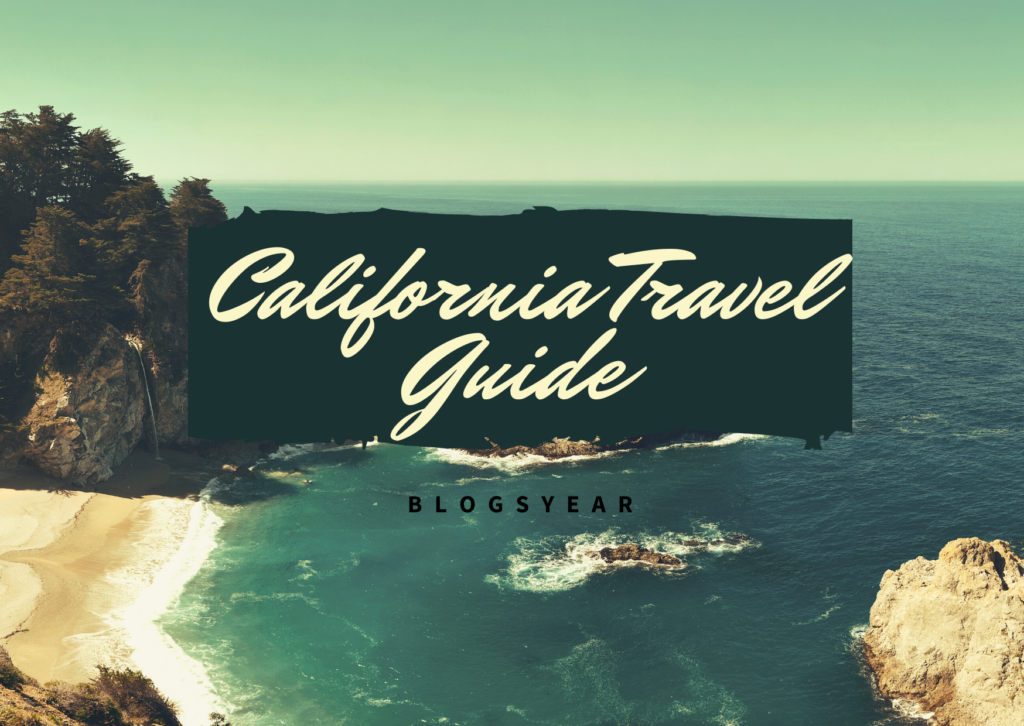California Travel Guide-What to do in California

I may be slightly partial because I’m from California, but I think it’s the most interesting state in the USA to travel to. California is frequently glorified in movies and popular culture for good reason—this state is brimming with sunlight and a spirit of adventure! This amazing place has so much to offer, from wonderful weather to magnificent amusement parks, intriguing history, stunning National Parks, and challenging hiking trails.
Also Read:- 10 Best Places to Visit in Europe
The natural splendour of the Redwood forest, Joshua Tree, and Big Sur will astound you. And you’ll enjoy visiting big towns like Los Angeles, San Francisco, and San Diego. California is one of my favourite places in the world thanks to its fantastic food, terrific road trips, fascinating camping areas, and amazing sightseeing options.
You’ll be shocked to see some colder, gloomier weather in May and June because California actually has a late summer. The hot period runs from July until September. My absolute favourite month in Southern California is October. The weather is a perfect mix of warm and cold, and you get the BEST sunsets.
Coachella and Stagecoach kick off the festival season in April, but it lasts pretty much all year long! Additionally, there are KAABOO, Outside Lands, CRSSD Festival, and Lightning in a Bottle. In addition to music festivals, there are other events like the Pebble Beach Concours d’Elegance and the Hot Air Balloon Festival in my hometown of Temecula.
Don’t let the colder months deter you from travelling there because California boasts the nicest weather all year long.
California has an impressive reputation as a terrestrial paradise of sun, sand, and surf, as well as fast-paced, glamorous cities, ancient old-growth forests, and significant desert expanses. It is widely known and idolised on a global scale. Although it has been the centre of some of the nation’s most progressive movements, including the civil rights, modern environmentalist, and other reform movements, its economy has only recently begun to recover from the 2008–12 state budget crisis, which narrowly prevented bankruptcy. Despite its economic ups and downs, California’s GDP continues to be higher than that of the majority of European nations, and thanks in large part to Hollywood, the “Golden State” continues to have an unbreakable hold on the world’s imagination.
Great Places to Visit in USA- Here Are the List of California Travel Guide
Depending on your goals, California is far too big to be thoroughly seen in a single trip. Undoubtedly the largest and most interesting city is Los Angeles, which is famous for its whale watching los angeles tours, is also made up of a dizzying array of diverse neighbourhoods connected by miles of congested freeways. These neighbourhoods range from the Mexican and Japanese neighbourhoods in the downtown area to the family-friendly Disneyland to the glitz of Beverly Hills and the chaos of Venice Beach. Further inland, the deserts, most notably Death Valley, make up a barren and inhospitable landscape of volcanic craters and saltpans that in summer becomes the hottest place on earth. To the south, the more conservative metropolis of San Diego has broad, welcoming beaches, great food (featuring delicious tacos considering its proximity to Mexico), and a renowned zoo. The central coast is a stunning route that passes through vibrant small towns like Santa Barbara and Santa Cruz as you travel north.
San Francisco, the second largest city in California, is a European-inspired gem with steep hills, wooden Victorian homes, and other distinctive features. Yosemite, where waterfalls drop down a vertical glacier valley, Sequoia/Kings Canyon, with its enormous trees, and the ghost settlements of the Gold Country are just a few of the captivating national parks to the east. In the region north of San Francisco, which is dotted with volcanic tablelands and lush mountains, it gets wilder, wetter, and greener.
As you might anticipate, a car is required to travel around a lot of California (see our feature on the best California road trip routes). A city like Los Angeles couldn’t survive without the vehicle, and anyhow, it’s too much fun to pass up zipping down the freeways along the coast in a sporty convertible. Travelling from north to south can also make a big impact if you intend to undertake any long-distance riding because the wind naturally blows that way in the summer and the ocean side of the road has the best vistas.
Travel History
Sebastián Vizcáino gave most of the place names that are still used today. His exaggerated description of Monterey as a perfect harbour led later Spanish colonists to make it the region’s military and administrative centre. Spanish explorer Juan Cabrillo named California after an imaginary island from a Spanish novel when he first sighted San Diego harbour in 1542, but Sebastián Vizcáino gave most of the place names that are still used today. By 1804 a chain of 21 missions, each a hard day’s walk from the next along the dirt path of El Camino Real (The Royal Road), went from San Diego to San Francisco. Father Junpero Serra first founded a tiny Catholic mission and presidio (fort) at San Diego. Native Americans who managed to escape the Spanish invasion were either forced to convert to Catholicism or killed by sickness.
Despite the extreme difficulty of travelling to the Mexican state (three months by sea or four months by covered wagon), Americans had already begun to arrive by the time Mexico gained its independence in 1821 and seized control of California. The imperialist tactics of President James K. Polk, which showed a rising idea that it was the United States’ Manifest Destiny to conquer the continent from coast to coast, sparked the short Mexican-American War. Spanish-speaking Californians were steadily pushed to the margins by the Americans who had taken control of the whole West Coast by January 1847. California became the 31st state in 1850.
The 1849 Gold Rush not only produced California, but also ensured that the American West would be settled within a few decades. Flakes of gold were found in the Sierra Nevada just nine days before the treaty that put an end to the Mexican-American War, which sparked a rush of prospectors from all over the world. The transcontinental railroad, which connected the gold fields to the rest of the USA, was finished in 1869 after only fifteen years of clearing the ground of any discernible gold. Hordes of immigrants from the Great Plains moved to Southern California due to low rail fares, the allure of a dry, warm climate, and the abundance of citrus trees, which helped establish Los Angeles the state’s largest city. This movement, together with sporadic real estate booms and the growth of the film industry, helped California become the state with the fastest rate of population growth in the country. During World War II, heavy industry followed in the shape of shipyards and aeroplane factories.
California was on the cutting edge of cultural change since it was the birthplace of the Beats in the 1950s and the hippies in the 1960s. When Proposition 13 in 1978 signalled a national trend to dramatically cut taxes at the expense of government solvency, the economic counterpart to this move also emerged (not resolved until the passage of Proposition 30 in 2012 signalled a dramatic reversal). With a string of Republican governors who promoted laissez-faire policies, the right made further gains in the 1980s. The 1990s, however, were marred by economic scandal, a slump in the housing market, rising unemployment, gang violence, and racial riots in Los Angeles, which were further exacerbated by earthquakes, drought, and flooding.
The golden state’s lustre has dimmed a bit more in the twenty-first century, but many new immigrants, many of them from Latin America, are coming. One of these immigrants, Austrian Arnold Schwarzenegger, had the good fortune to become a successful action movie star before serving as the 38th governor of California. He had the bad luck to hold office during the most recent, extremely bad economic recession, which contributed to the state’s economy weakening and pushing the unemployment rate above twelve percent. Democratic governor Jerry Brown, who took over for Schwarzenegger in 2011, signed the state’s first balanced budget in years, ushering in what Californians believe would be the start of a long-term recovery. By 2013, the Democrats held majorities in both houses of the state legislature.
California’s San Joaquin Valley and Bakersfield
The Sierra Nevada, also known as the High Sierra, is a sawtooth range of snow-capped peaks that rises high above the Owens Valley’s semi-desert and divides the vast interior of California in half. The name Sierra Nevada is Spanish for “snowy range.” Irrigation operations in the 1940s made the large San Joaquin Valley in the west fruitful, and it is today almost entirely agricultural.
The largest Basque community in the nation and one of the most vibrant country music scenes are both located in the flat, colourless oil town of BAKERSFIELD. It gained notoriety for its distinct “Bakersfield Sound” in the late 1950s and early 1960s. This musical style, which was significantly less polished and mainstream than Nashville, Tennessee’s, was typified by the gutsy honky-tonk of local musicians like Merle Haggard and Buck Owens. Bakersfield’s honky-tonks are hopping every Saturday night, when Stetson hats and fringy shirts are the mandatory attire and audiences span generations. Even now, the city acts as somewhat of an alternative to the glossy country pop coming from Tennessee.
The Bay Region
Only one in eight of the almost seven million people who reside in San Francisco’s area actually reside in the city. The rest of the population is dispersed over the Bay Area, a starkly different patchwork of primarily wealthy and some impoverished settlements scattered throughout the peninsula or across one of the three spectacular bridges that traverse the frigid waters of the exquisite natural harbour. While intelligent Berkeley and hardworking Oakland are located in the East Bay, Silicon Valley is located on the Peninsula, south of the city. The wooded, green terrain and craggy coastline of Marin County, which is located to the north across the Golden Gate Bridge, are a blend of conspicuous luxury and abundant natural beauty.
Berkeley
The University of California, one of America’s most renowned institutions of higher study and particularly well-known for its progressive politics, dominates Berkley, which was named after the English philosopher-theologian George Berkeley. Even though the campus now takes pride in its excellent academic standings and faculty that is replete with Nobel laureates, the term Berkeley still conjures up thoughts of resistance, and it remains a staunchly left-wing enclave. The Free Speech Movement started in Sproul Plaza, which is located in front of Sather Gate, the school’s main entrance. Take a stroll through the campus’s tree-lined lanes or sign up for one of the free student-led tours that depart from the magnificent Campanile (Mon–Sat 10am, Sun 1pm).
The campus’s opulent structures and thirty thousand students radiate vitality that spills south down rowdy Telegraph Avenue, where dishevelled sellers peddle rainbow wristbands in front of vegetarian restaurants, pizza shops, book- and music stores, and other businesses. A short distance away lies the now-quiet People’s Park, which saw almost daily pitched clashes between protesters and police during the Vietnam War uprising in the 1960s and early 1970s.
Older academics congregate in Northside, coming out of their wooded hillside houses to enjoy treats from the renowned Chez Panisse and other restaurants, delis, and bakeries in the Gourmet Ghetto on Shattuck Avenue (see p.897). Tilden Regional Park, located north of here on the hills, includes lovely rose gardens and wonderful pathways. You may rent sailboats and windsurfing boards at the Berkeley Marina along the bay, or you can just sit and watch the sun set behind the Golden Gate.
County of Marin
A pleasure zone of obvious luxury and abundant natural beauty, with sunshine or fog, sandy beaches, high mountains, and dense redwood forests, Marin County is an unabashed introduction to Californian self-indulgence in wonderful natural surroundings. Marin County is located across the Golden Gate from San Francisco. Although the area used to be a logging hub, it is now one of the wealthiest in the USA and draws young professionals to its upscale waterfront communities.
San Jose
Today, Burt Bacharach might easily locate SAN JOSE by travelling from San Francisco in the south and following the heat and smog that gathers below the Bay. Even though it is one among California’s fastest-growing cities and is nearly twice the size of San Francisco in terms of land and population, it lacks a strong sense of identity. At the southern tip of the peninsula, San Jose has developed over the past thirty years into the political hub of Silicon Valley. Ironically, it is also recognised as the founding city of California, albeit the sole physical reminder of this is the nondescript 18th-century Mission Santa Clara de Asis, located on the lovely campus of Santa Clara University, a Jesuit institution.
The Winchester Mystery House, 525 S Winchester Blvd, is the most well-known monument in the neighbourhood. Sarah Winchester, who succeeded to the Winchester gun wealth after her husband died in 1884, erected the obscene home to placate the ghosts of those killed by the firearms. A stunning collection of Assyrian and Babylonian artefacts may be found at the Rosicrucian Egyptian Museum, 1660 Park Avenue, while the renovated Tech Museum of Innovation, located downtown at 201 S Market St, offers interactive exhibits of cutting-edge engineering as well as an IMAX theatre.
This Article Objectives:- Blogsyear provide California Travel guide Information thriugh this Article. Check out our other travel guides Article to provide accutrate information to all readers








